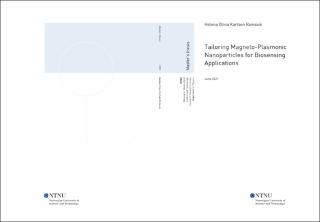| dc.contributor.advisor | Bandyopadhyay, Sulalit | |
| dc.contributor.advisor | Davies, Catharina de Lange | |
| dc.contributor.advisor | Zürbes, Katharina | |
| dc.contributor.author | Ramsvik, Helena Olivia Karlsen | |
| dc.date.accessioned | 2021-11-09T18:26:05Z | |
| dc.date.available | 2021-11-09T18:26:05Z | |
| dc.date.issued | 2021 | |
| dc.identifier | no.ntnu:inspera:81580153:36592924 | |
| dc.identifier.uri | https://hdl.handle.net/11250/2828790 | |
| dc.description.abstract | Biosensorer er i dag uerstattelige verktøy i svært mange biomedisinske felt, inkludert klinisk diagnostikk. Flere virus, som blandt annet humant immunsvikt virus (Hiv), hepatitt B-virus (HBV) og morbillivirus (meslingevirus), kan identifiseres ved bruk av biosensor-teknologi. Utbruddet av koronaviruset (COVID-19) er et utmerket eksempel på hvordan tidlig påvisning av en virusinfeksjon er avgjørende for å forhindre spredning av sykdommen. Dagens biosensorer begrenses av både sensitiviten og selektiviteten på biomolekylet som skal detekteres, i tillegg til at selve deteksjonen ofte er en tidskrevende prosess. Å lage biosensorer ved bruk nanoteknologi, kan bidra til å øke kvaliteten på biosensorer betraktelig.
Magneto-plasmoniske nanopartikler (NP) er partikler bestående av et magnetisk og et plasmonisk materiale fusjonert sammen til én nanopartikkel. Grunnet deres to-delte natur, har disse partiklene både en lokal overflate plasmon resonansfrekvens (LSPR) og superparamagnetisk oppførsel.
I løpet av dette arbeidet har anisotrope magneto-plasmoniske partikler blitt syntetisert gjennom heterogen vekst av gull på forskjellige typer jern-holdige NP kjerner. Ved å variere egenskapene til kjernene og reaksjonsbetingelsene for syntesen, ble egenskapene til de resulterende partiklene justert til å være optimale til bruk i biosensor-teknologi. Det ble funnet at det å bruke cetyltrimetylammoniumbromid dekte jern-oksid (IO-CTAB) NP kjerner, i en vekstløsning med lavt sølvnitratinnhold kombinert med en høy pH, resulterte i de anisotrope magneto-plasmoniske NP som var mest egnet til bruk i biosensing. | |
| dc.description.abstract | Today, biosensors are ubiquitous in a wide range of biomedical applications, including clinical diagnostics. Several viruses, including the human immunodeficiency virus (HIV), hepatitis B virus and the measles virus, have already been successfully detected using biosensing technology. The outbreak of coronavirus disease (COVID-19), is an excellent example on how early detection of infection is crucial in preventing the spread of a virus. However, the applications of many of today's biosensors are restricted due to the sensor's level of sensitivity and selectivity to the target molecule, as well as being time-consuming processes. Nanomaterial-based biosensors can be a good alternative in order to overcome these challenges.
Magneto-plasmonic nanoparticles (NPs) are particles composed of one magnetic and one plasmonic material combined together into a single nanoparticle through solid-solid interfaces. Due to their dual nature, these particles exhibit both a local surface plasmon resonance (LSPR) and superparamagnetic behavior.
In this work, anisotropic magneto-plasmonic particles have been synthesized by seed-mediated growth of gold on different iron-containing NPs. By varying the properties of the seed and the reaction conditions of the synthesis, the physico-chemical properties of the resulting particles were tuned to be optimal for use in biosensing applications. It was found that the cetyltrimethylammonium bromide capped iron oxide (IO-CTAB) NP seeds, used in a growth solution with a low silver nitrate content combined with a high pH, resulted in the anisotropic magneto-plasmonic NPs most suitable for biosensing applications. | |
| dc.language | eng | |
| dc.publisher | NTNU | |
| dc.title | Tailoring Magneto-Plasmonic Nanoparticles for Biosensing Applications | |
| dc.type | Master thesis | |
